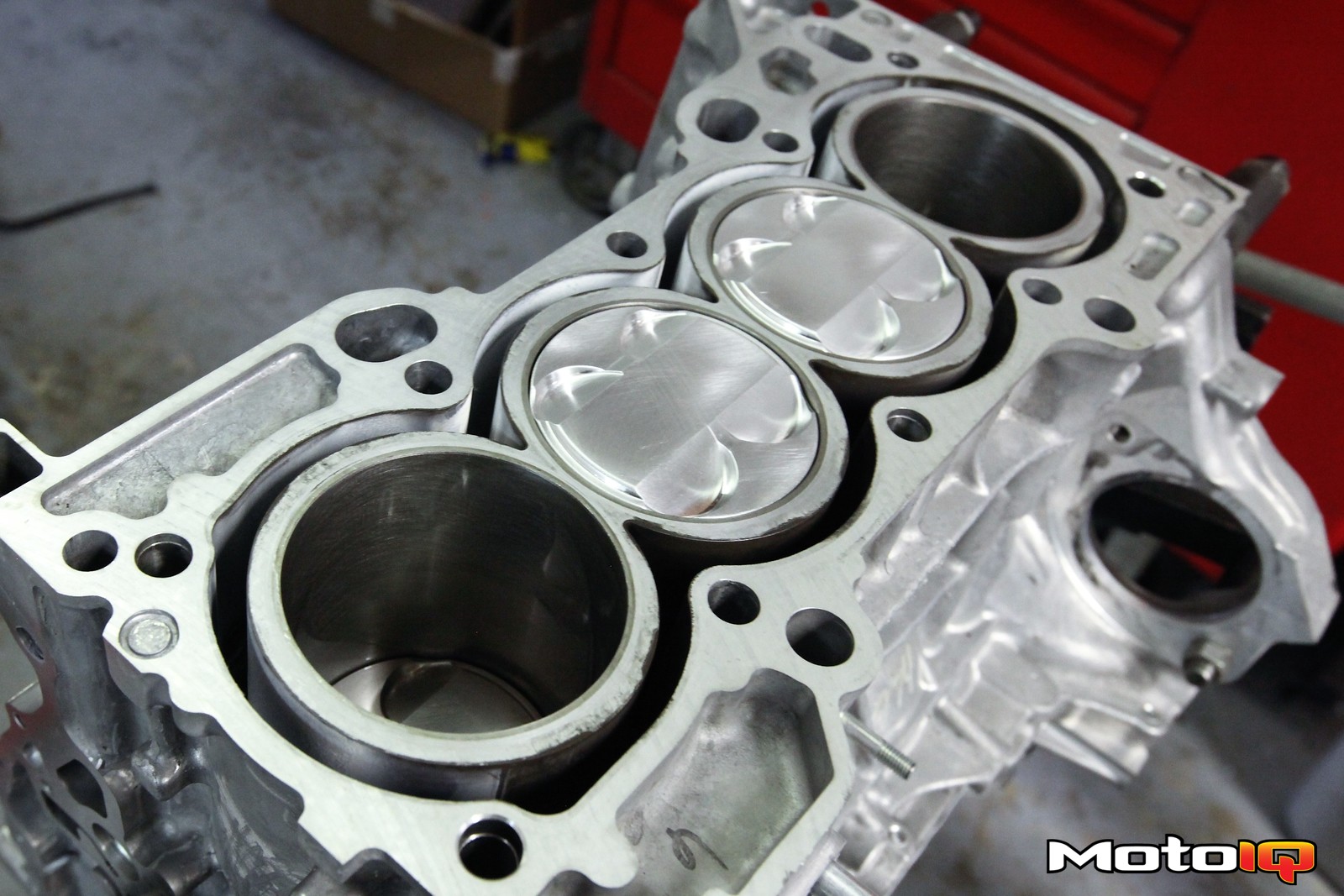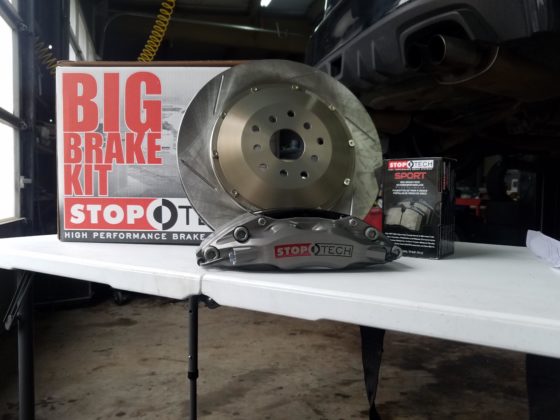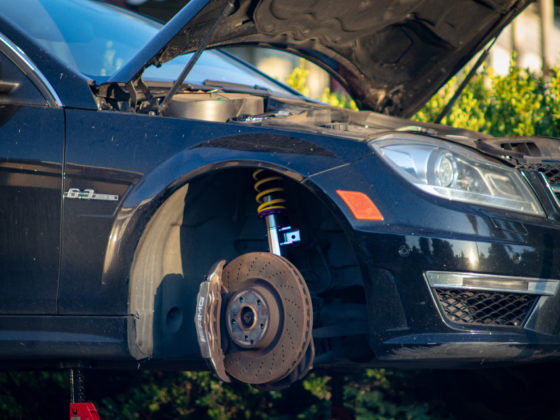
So the MotoIQ garage is in the process of building a pretty neat car, restoring a well worn DC5 RSX to better than its formal glory. The story starts here with the engine. Our mission was to build something that was powerful, flexible and reliable with the ability to run easily on the worst pump gas in the country without a problem, namely 91 octane. We wanted to have something with good top end and sparking NA performance but with decent bottom-end torque to make it pleasant to drive. To do the motor and we must first start with the bottom end. To get an engine with great bottom-end torque, we decided to start with a K24A2 which is found on the 2004-2008 Acura TSX. With its 99mm stroke and 87mm bore the K24 will be a great bottom end to start with. To get the job done we are going to fortify it with parts from JE Pistons, K1 Technologies and King Bearings to reach our goals for reliable max pump gas power.

The base of our build uses JE’s Sport Compact shelf pistons part #361262 which is standard bore for a K24 bottom end with a K20A cylinder head. These pistons are built on JE’s FRS asymmetrical forging. This forging has a larger face on the thrust side of the piston for less noise and better cylinder wall and piston face wear with a small reduced face on the non-thrust side for less weight and friction. The asymmetrical forging gives you the best of both worlds low friction and lightweight of a slipper style skirt with the quietness and lower wear of a full face piston.
The FSR shelf pistons feature a dome volume of 2cc’s which yields a compression ratio of 11.5:1. This is a conservatively high compression ratio for a pump gas K motor. The piston uses JE’s new aligned grain flow forging method which uses multi-stage dies to get the metals grain orientation to flow around the piston. Metal like wood has a grain and being able to control which way it is oriented around the pistons internal and external geometry is a good advantage to getting the best strength and dimensional stability under all temperatures out of the piston.

The FSR piston is a strut-type forging. This places material around the support area of the pin boss but not to the edge of the bore. Strut forgings are lighter and use a shorter and lighter piston pin without sacrificing strength. In the case of this piston, a sturdy straight wall carbon steel piston pin is used. The pistons are forged out of 2618 low silicone alloy. This is a tough more ductile aluminum alloy. In the past 2618 pistons were known for there strength but also known to be noisy because they expanded more than other alloys like 4032 which required wider piston to wall clearances. However, JE has come up with advanced skirt profiles that allow the use of 2618 with less noise and slap.

Our JE pistons came with their perfect skirt coating. Perfect skit is a dry film lubricant coating that protects the cylinder walls and piston skirts from scuffing. Perfect skit also allows a tighter piston to wall clearance for less noise. The oval-shaped patches in the perfect skirt coating are measuring points with no coating so the true coatingless piston to all clearance can be determined. The pistons use JE’s low friction ring package using thin 1 mm nitrided steel first compression, 1.2mm steel second compression and 2.8 mm oil control rings. The rings have a naiper profile for improved seal and a fast break-in. Thin rings have much less radial tension, require less gas pressure to seal, conform to the piston walls better for a better seal, have less flutter and better seal due to inertia at TDC and have way less friction than conventional rings. Rings are the biggest source of frictional loss in an engine and account for 50% of the total friction as piston producers so these rings make a big difference in power, especial on a high revving NA engine.




6 comments
Hoping to do the same k24/k20 soon. Looking forward to the rest of the build!
Just wondering something: Why do you always choose the K24 bottom end in the states? Is that just for the longer stroke and therefore more displacement?
Assuming a K20 bottom end is the same, why not build a K24 bottom, with K20 bottom internals and longer conrods? (because the deck height is 19,5mm taller on the K24 engine). Smoother running and more RPM potential? Redline should theorectically be around 12000 RPM that way, and smoother running because of the smaller stroke? Sure, you loose a bit of torque that way, but you would gain top end power if you use the RPM potential with a high duration cam.
Or am i not seeing something here?
You make good points here, but I think in a street engine, spinning to 12k rpm is not feasible. If you can make more power at a lower rev range, and still have the ability to make power at 8000rpm why bother?
Meh, depends on how you build something. I had a pet project that was stolen years back: A-series engine. The BMC/Rover/Austin/Morris/MG one.
Long story short: 1046cc OHV engine (designed with 3 crank bearings in the late 1930’s as a generator on the back of a tank), capable of 12.000RPM (Normal is about 5500 RPM) Stil normally drivable. Even legal to drive with emissions here in Europe. Idled at 800 RPM without being overly lumpy. Although I must admit that it was running on BP Ultimate 102 RON.
In a way its compairable to an S2000. Just a regular engine down low until it wakes up once past 4500 RPM really. My point being: RPM limit at which an engine makes power does not neccesarily mean it’s a mut down low. Its just a different mindset when driving it. It isn’t as lazy driving as a bigger displacement engine though. So it would be feasable, but the biggest concern is going to be to find hypereutectic pistons that can handle the stress. Forged aluminum just expands to much. You either get a pinching engine op high, or burning oil if the engine is starting up.
And to answer your question: For me its always the challenge of building it. But it is a lot harder to do it right once you start using it in day to day life.
How much was this k20 Engine built $$$
JE piston makes nice products but their website is not one of them, it’s top notch web design from 1998 and filled with outdated/missing information.
I learned through e-bay that they now make coated asymmetrical pistons for BPs because JEs website still lists that piston as an uncoated round skirt.